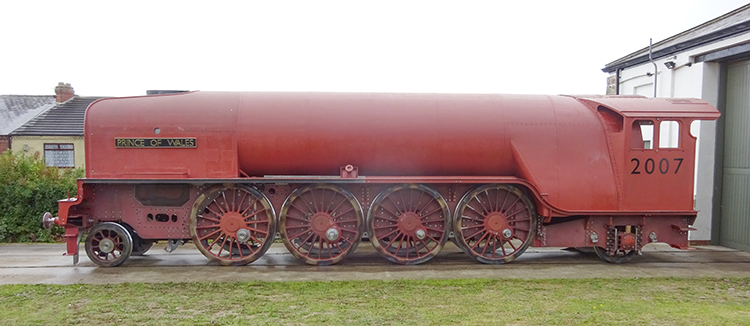01 June 2021
|
The A1 Steam Locomotive Trust commissions Frewer & Co Engineers Ltd of Dorking, Surrey to examine the exhaust plume effect on its new Gresley class P2 2-8-2 ‘Mikado’.
The project to build new Gresley class P2 steam locomotive No. 2007 Prince of Wales has shared details of a further application of modern techniques in the design and development of its improved P2 Class locomotive.
The 2-8-2 'Mikados' were the most powerful express passenger locomotives to operate in the UK. Designed by Sir Nigel Gresley in the 1930s for the London & North Eastern Railway (LNER) to haul 600T trains on the arduous Edinburgh to Aberdeen route, sadly, the design was never fully developed, and they were rebuilt by his successor Edward Thompson into ungainly class A2/2 4-6-2 ‘Pacifics’ in 1943/4 and scrapped by 1961.
The A1 Steam Locomotive Trust (A1SLT - registered charity and builders of famous new 100mph steam locomotive No. 60163 Tornado) is building the seventh member of this class at its Darlington Locomotive Works (DLW) over ten years, at an estimated cost of over £5m through its P2 Steam Locomotive Company subsidiary.
Despite the impact of COVID-19, progress on the construction of its new Gresley Class P2 ‘Mikado’ continues to move forward rapidly. The locomotive has reached the condition where it is recognisably a P2, and the structurally-complete tender tank and tender wheelsets are now at Darlington Locomotive Works.
Construction and assembly work continues on all fronts, including boiler, wheelsets, tender frames, heavy motion, pipework and electricals. Design work for the extensively modified and improved cylinder block is complete, with the focus now turned to adaptation of the Lentz rotary cam poppet valve gear to further improve the original design.
Following the successful partnership with Frewer & Co Engineers Ltd announced in March 2021 where Frewer undertook the Computational Fluid Dynamics (CFD) analysis of the cylinder block steam passageways, a further project has been commenced.
The second of the original Gresley class P2s No. 2002 Earl Marischal, was completed at Doncaster Works five months after No. 2001 Cock o ’the North in October 1934. Unlike No. 2001, which was equipped with Lentz-type rotary-cam actuated poppet valve-gear supplied by the Associated Locomotive Equipment Company, No. 2002 was fitted with Walschaerts valve gear as used on the Gresley class A1 and A3 ‘Pacifics’. As a consequence, No. 2002 was documented as suffering from issues with exhaust steam obscuring the view of the driver. The problem was initially addressed by fitting additional smoke deflectors to No. 2002 and was finally resolved with the fitment of a Gresley class A4-style streamlined front-end to the class P2s.
The final four Gresley class P2s, No. 2003 - No. 2006, were fitted with the streamlined front-end from new in 1936, No. 2002 in 1936 and No. 2001 in 1938 when also rebuilt with Walschaerts valve gear. To ensure that No. 2007 doesn't suffer from the same problem with the original Gresley class P2 boiler casing design, a CFD study of the influence of the exhaust steam over the casing is currently underway. The 'Coanda' effect is the tendency of a fluid to follow a flat or curved surface. In the case of the class P2, a crosswind travelling over the casing will ‘stick’ to the casing and draw the exhaust steam down over the surface obscuring the Driver’s view of the railway ahead. The study aims to replicate the documented problem in the simulation environment. If this is achieved, design changes can be tested to investigate how to prevent the problem occurring with No. 2007 - the intention being to find a means of influencing the air and steam flow that doesn't change the design outline of the locomotive’s boiler casing.

Ben McDonald, Group Director of Engineering, A1SLT, commented, “The commissioning of Frewer to undertake a Computational Fluid Dynamics analysis of the influence of the Coanda effect on the exhaust steam over the casing is part of the continued application of modern techniques in the design and development of our improved class P2, completing the work of Sir Nigel Gresley from the 1930s.”
Martha Cooper, Head of Advance Analysis Division, Frewer, commented: “We are very excited to be contributing to this project, and it is a unique opportunity to demonstrate how modern analysis tools and capabilities can be applied to a classic design, inspiring the next generation of engineers. We have found it really interesting to work closely with A1SLT and appreciate the expertise and attention to detail, both in Gresley’s original and in the modern improvements to the design.”
For further details on the new-build locomotive project, including how to become involved, visit its website.
Are you subscribed to our weekly e-mail newsletter? Don't miss the latest news, reviews, modelling advice and competitions.

